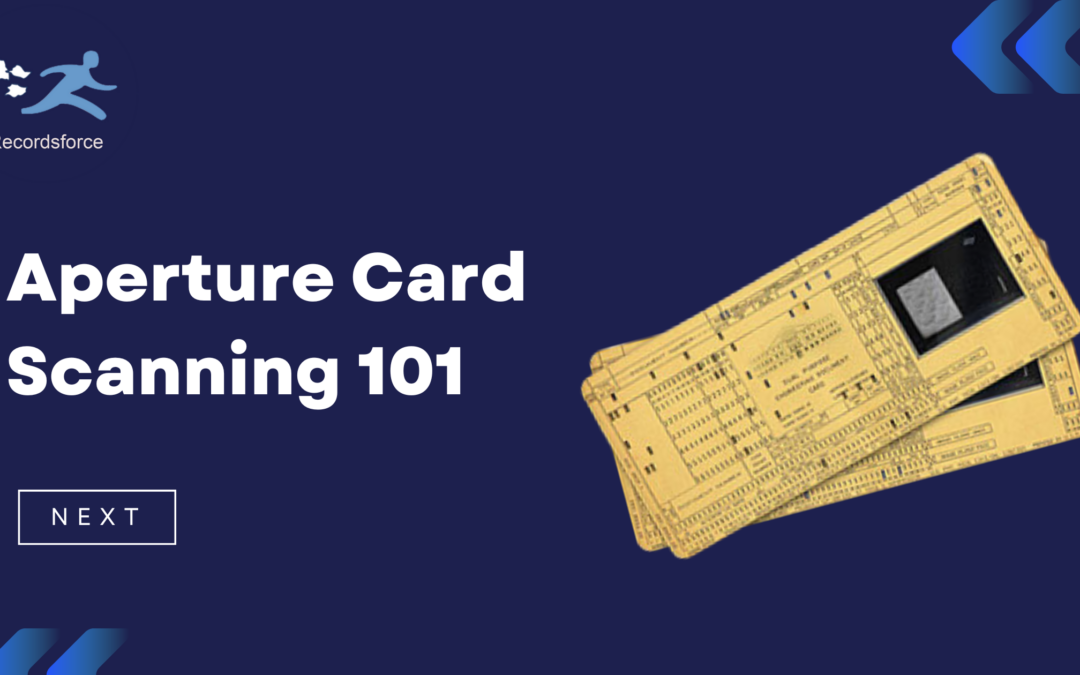In a past world, aperture cards were an extremely useful form of microfilm for archiving important information. You may have seen these types of cards in engineering or building departments, as there were certain advantages to using this type of technology to archive engineering drawings or building plans. Aperture cards have a projected 500 year lifespan, and they are human readable, which prior to computers made them a very reliable and easily searchable form of archiving. If you are unfamiliar, aperture cards typically look like a wide index card (approx. 7.5” x 3.25”) with a piece of microfilm mounted on one side and punch holes throughout the card. The punch holes are known as the Hollerith data and they represent important metadata, as well as card index information that would describe the specifics of the image without needing to actually look at the image itself.
In the modern world, this form of archiving is outdated. With so many digital systems available today, the idea of manually thumbing through thousands of aperture cards is foreign to the younger generation. Not to mention, retrieval that would take a matter of seconds on any digital system, can take 20-30 minutes, or even days, when it’s all said and done in a physical storage scenario. Aperture cards also need to be stored in a climate controlled environment, which means the cost of physical storage is greater than your typical paper files, as they must be stored indoors. Companies like Recordsforce have clients that pay annually to store physical aperture cards and retrieve specific cards as needed due to the controlled storage requirements.
“What should I do if I want to digitize my aperture cards?”
Aperture cards are unique and require a certain type of scanner to capture the images and data properly. If you have one of these scanners, great! If not, you will need to talk to a professional who can help you with your digital transformation. There are certain questions anybody who is going to digitize your aperture cards is going to want answers to that you should be prepared to answer.
How many cards do you have?
If you don’t know the exact amount there are ways to estimate a general approximation. Using a ruler, measure approximately 1 inch of aperture cards squeezed together, and then count how many were included within that inch. That number should be about 100. Once you have that number you can measure the total number of linear feet you have to calculate the total number of cards (i.e.: 100 cards per inch, 100 inches of cards, 100 x 100 = 10,000 cards.
How would you like the cards indexed?
Indexing is the manner of how you want your cards named, and how you search for them. There are different areas on the card where data can be collected, so it is important to determine which one you want used for retrieval and identification.
- Hollerith Data: If you have Hollerith aperture cards, Recordsforce is able to capture the index information right from the hole punches. Our unique scanner captures the Hollerith data and turns it into digital index information.
- Title Block: If there is no Hollerith, or if the Hollerith is suspect, the title block at the top of the card can be used. Information related to the image is generally here, such as a sheet number, project number, and so on. This information can be captured through manual keying after the card has been scanned.
- Writing contained on the card: Cards might have typed or handwritten information on other parts of the card that is not the title block, which can be captured if required.
- Directly from the image: The image may contain information you need, even if there is Hollerith, title block, and/or writing on the card. If that’s the case, the scanned image will be used to capture and key the required information.
How would you like your digital images delivered to you?
Recordsforce has the ability to deliver images via a secure online transfer (SFTP), directly into your system via a bulk upload, via a secure thumb drive, or via our cloud based document management system. It is important to understand how you use the cards now, and how you would like to access them in the future in order to properly route your new digital copies to the right place.
Once you have this information gathered, you are prepared to have a professional properly digitize your aperture cards. Pricing for scanning aperture cards is typically based on how many you have, what information you want pulled from the cards (indexing), and how you want them delivered. If you have this information available, you could even use something like our aperture card quote generator to start to assess the costs of a project like this.
Recordsforce has extensive experience turning physical aperture cards into digital images and data. We are happy to help teams modernize their records management processes, and aperture cards are something we come across everyday.

